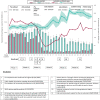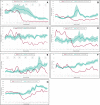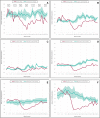Impact of the COVID-19 pandemic on gastrointestinal infection trends in England, February-July 2020
- PMID: 35314468
- PMCID: PMC8968111
- DOI: 10.1136/bmjopen-2021-050469
Impact of the COVID-19 pandemic on gastrointestinal infection trends in England, February-July 2020
Abstract
Objective: To establish the impact of the first 6 months of the COVID-19 outbreak response on gastrointestinal (GI) infection trends in England.
Design: Retrospective ecological study using routinely collected national and regional surveillance data from seven UK Health Security Agency coordinated laboratory, outbreak and syndromic surveillance systems using key dates of UK governmental policy change to assign phases for comparison between 2020 and historic data.
Results: Decreases in GI illness activity were observed across all surveillance indicators as COVID-19 cases began to peak. Compared with the 5-year average (2015-2019), during the first 6 months of the COVID-19 response, there was a 52% decrease in GI outbreaks reported (1544 vs 3208 (95% CI 2938 to 3478)) and a 34% decrease in laboratory confirmed cases (27 859 vs 42 495 (95% CI 40 068 to 44 922)). GI indicators began to rise during the first lockdown and lockdown easing, although all remained substantially lower than historic figures. Reductions in laboratory confirmed cases were observed across all age groups and both sexes, with geographical heterogeneity observed in diagnosis trends. Health seeking behaviour changed substantially, with attendances decreasing prior to lockdown across all indicators.
Conclusions: There has been a marked change in trends of GI infections in the context of the COVID-19 pandemic. The drivers of this change are likely to be multifactorial; while changes in health seeking behaviour, pressure on diagnostic services and surveillance system ascertainment have undoubtably played a role, there has likely been a true decrease in the incidence for some pathogens resulting from the control measures and restrictions implemented. This suggests that if some of these changes in behaviour such as improved hand hygiene were maintained, then we could potentially see sustained reductions in the burden of GI illness.
Keywords: COVID-19; epidemiology; gastrointestinal infections.
© Author(s) (or their employer(s)) 2022. Re-use permitted under CC BY-NC. No commercial re-use. See rights and permissions. Published by BMJ.
Conflict of interest statement
Competing interests: None declared.
Figures






Similar articles
-
Understanding the impact of the COVID-19 pandemic response on GI infection surveillance trends in England, January 2020-April 2022.Epidemiol Infect. 2023 Aug 25;151:e147. doi: 10.1017/S095026882300136X. Epidemiol Infect. 2023. PMID: 37622322 Free PMC article.
-
Mental Health Presentations Across Health Care Settings During the First 9 Months of the COVID-19 Pandemic in England: Retrospective Observational Study.JMIR Public Health Surveill. 2022 Aug 3;8(8):e32347. doi: 10.2196/32347. JMIR Public Health Surveill. 2022. PMID: 35486809 Free PMC article.
-
Using a novel 'difference-in-differences' method and syndromic surveillance to estimate the change in local healthcare utilisation during periods of media reporting in the early stages of the COVID-19 pandemic in England.Public Health. 2024 Jul;232:132-137. doi: 10.1016/j.puhe.2024.04.022. Epub 2024 May 22. Public Health. 2024. PMID: 38776588
-
Emergency department use during COVID-19 as described by syndromic surveillance.Emerg Med J. 2020 Oct;37(10):600-604. doi: 10.1136/emermed-2020-209980. Epub 2020 Sep 18. Emerg Med J. 2020. PMID: 32948621 Free PMC article.
-
Global Impact of COVID-19 Pandemic on Gastrointestinal Infections: A Scoping Review.Foodborne Pathog Dis. 2024 Nov 26. doi: 10.1089/fpd.2024.0047. Online ahead of print. Foodborne Pathog Dis. 2024. PMID: 39588900 Review.
Cited by
-
[Impact of the pandemic on various infectious diseases with different epidemiological patterns of seasonality, transmission and age].Rev Esp Salud Publica. 2024 Feb 21;98:e202402011. Rev Esp Salud Publica. 2024. PMID: 38385502 Free PMC article. Spanish.
-
The evolution and international spread of extensively drug resistant Shigella sonnei.Nat Commun. 2023 Apr 8;14(1):1983. doi: 10.1038/s41467-023-37672-w. Nat Commun. 2023. PMID: 37031199 Free PMC article.
-
The re-emergence of sexually transmissible multidrug resistant Shigella flexneri 3a, England, United Kingdom.NPJ Antimicrob Resist. 2024;2(1):20. doi: 10.1038/s44259-024-00038-3. Epub 2024 Aug 2. NPJ Antimicrob Resist. 2024. PMID: 39100870 Free PMC article.
-
'A system that is struggling': understanding health protection resilience in England during the COVID-19 pandemic through the experiences of local health protection responders.BMC Health Serv Res. 2024 Feb 8;24(1):181. doi: 10.1186/s12913-024-10651-7. BMC Health Serv Res. 2024. PMID: 38331750 Free PMC article.
-
Impact of COVID-19 Restrictions on Acute Gastroenteritis in Children: A Regional, Danish, Register-Based Study.Children (Basel). 2023 Apr 29;10(5):816. doi: 10.3390/children10050816. Children (Basel). 2023. PMID: 37238364 Free PMC article.
References
-
- Dunn P, Allen L, Cameron G. Covid-19 policy tracker: a timeline of national policy and health system responses to covid-19 in England, 2020. Available: https://www.health.org.uk/news-and-comment/charts-and-infographics/covid... [Accessed 18 Nov 2020].
-
- Ahuja S, Shah P, Mohammed R. Impact of COVID-19 pandemic on acute spine surgery referrals to UK tertiary spinal unit: any lessons to be learnt? Brit J Neurosurg 2020. - PubMed
Publication types
MeSH terms
LinkOut - more resources
Full Text Sources
Medical
